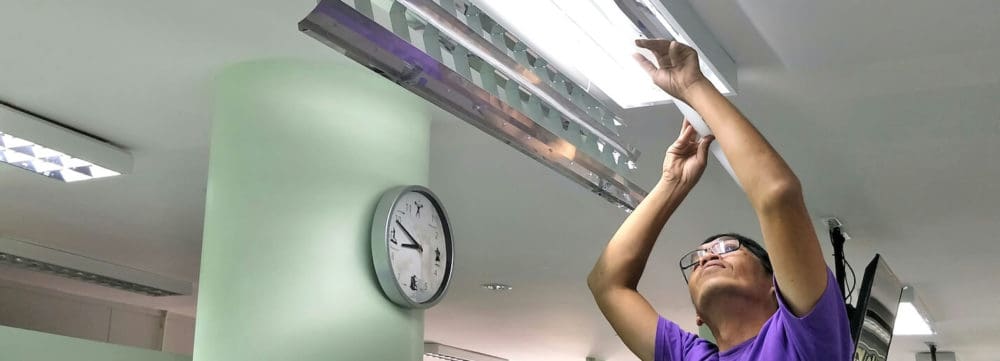Blog
Designing Modern Operating Rooms for Stress Relief, Cost Effectiveness and Green Energy

Operating Rooms are one of the most important aspects of a hospital. They are places where lives are saved, complicated surgeries are done, and where medical staff spend hours on their feet. ORs are profit centers for hospitals, but also use a great deal of resources.
All of this means healthcare designers need to pay extra attention to the interior decor, the room layout, and the materials used when designing operating rooms. In this article, we will look at three of the most important elements of quality operating room design principles.
Stress Relief
Clemson University and the Medical University of South Carolina have been working together on a project that looks for safer and less stressful OR environments. The end result of the project was the construction of a 579 sq. ft. operating room prototype designed specifically to reduce stress for medical staff.
One of the fundamental characteristics of the prototype was flexibility and adaptability. The prototype OR had ancillary rooms that were modular and could be adapted to different circumstances. The room also had overhead surgical lights that could be reconfigured easily.
The prototype was also designed to optimize movement and flow. The researchers noted that the layout of an OR can give medical staff stress in different ways. For example, certain layouts cause more incidents of staff tripping over cables or bumping into equipment. The prototype room was designed in four quadrants, which minimized these incidents and reduce staff stress levels.
The researchers also found daylighting and artificial lighting strategies could also lower stress levels. Views of the outdoors, even from an OR, increased staff satisfaction, mood, and productivity.
Cost-Effectiveness
The Facility Guidelines Institute’s Guidelines for Design and Construction of Hospitals has specific guidelines for ORs, in particular, the importance of wall and floor surfaces and how these surfaces relate to cost-effectiveness.
One important aspect designers should consider when selecting wall surfaces for ORs is durability. ORs are busy places with people and equipment constantly moving in, out and around the room, which can lead to nicks and scrapes in the walls. In addition to making the OR less aesthetically pleasing, nicks and scrapes can become home to microbes and pathogens. The more damage done to the surface, the more difficult it becomes to properly clean and disinfect.
According to the FGI, healthcare designers should consider materials that are resistant to both impact and cleaning materials, such as hot water or chemicals. The FGI’s guidelines note that epoxy paint can be cost-effective because it’s easy to clean, but it is not impact resistant. Wall panels are often used instead because they are both resistant to impact and nonporous, so they are easy to clean and less susceptible to pathogen contamination.
Green Energy
Jodi Sherman, M.D., associate professor of anesthesiology at the Yale School of Medicine, said in a commentary published in the Journal of the American Medical Association, that the health care industry “is a significant source of greenhouse gases and other deadly environmental emissions itself.” ORs are a significant percentage of this pollution, but there are steps that designers can take to help make ORs more green energy-friendly.
For example, at Providence St. Peter Hospital in Olympia, Washington, two of its ORs were fitted with high-efficiency, direct-drive HVAC units. These systems were designed so that air exchange slows down when people aren’t in the room, saving on energy usage. The rooms are also designed with recirculating air systems to minimize the use of outside air, which also saves on energy usages.
Marie Wikoff is the creator of Wikoff Design Studio based out of Reno, Nevada. Her expertise in healthcare design has helped modernize healthcare organizations locally, regionally, and internationally, improving patient experience and outcomes. Her credentials include Evidence-Based Design Accreditation and Certification (EDAC), American Academy of Healthcare Interior Designer (CHID), the National Council of Interior Design Qualification (NCIDQ) and LEED AP. Contact Marie Wikoff
Sources
Palmer, Gary, et al. “Realizing Improved Patient Care through Human-Centered Operating Room Design: a Human Factors Methodology for Observing Flow Disruptions in the Cardiothoracic Operating Room.” Anesthesiology, U.S. National Library of Medicine, Nov. 2013, www.ncbi.nlm.nih.gov/pubmed/23811697.
FGI, FGI. “Guidelines for Design and Construction of Hospitals.” Facility Guidelines Institute, Facility Guidelines Institute, 2018, www.fgiguidelines.org/guidelines/2018-fgi-guidelines/.
Sherman JD, MacNeill A, Thiel C. Reducing Pollution From the Health Care Industry. JAMA. Published online August 02, 2019322(11):1043–1044. doi:10.1001/jama.2019.10823, https://jamanetwork.com/journals/jama/article-abstract/2747470







